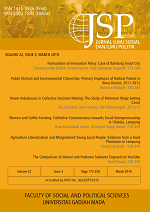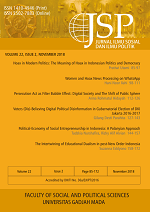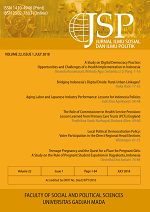A Study on Digital Democracy Practice: Opportunities and Challenges of e-Health Implementation in Indonesia
Bevaola Kusumasari(1), Widodo Agus Setianto(2*), Li Li Pang(3)
(1) Lecturer at the Department of Public Policy and Management, Faculty of Social and Political Sciences, Universitas Gadjah Mada
(2) Lecturer at the Department of Communications Science, Faculty of Social and Political Sciences, and Researcher at the Center for Southeast Asian Social Studies, Universitas Gadjah Mada
(3) Lecturer at UBD School of Business and Economics, Universiti Brunei Darussalam
(*) Corresponding Author
Abstract
As a developing country, Indonesia faces a crucial issue concerning the provision of health services to the public. The 1998 political reform led to demands for more aspiring and accommodating bureaucratic services being afforded to the public. The political reform brought about bureaucratic reform bearing good governance, wherein one of its forms is the provision of health services through the innovation of an information technology (IT) based service named e-Health. Keeping in mind Indonesia’s characteristics as a developing country, the implementation of IT-based services evokes numerous debates. This study aims to analyze the implementation of e-Health along with the opportunities it has, and the challenges it faces. By using a study case approach on the Surabaya Municipality Health Authority as the initiator and implementer of e-Health, as well as observations and user surveys, the results show that in spite of having been prepared properly with supporting policies, infrastructure, budgeting, dissemination, and operational system, there were still many prevalent obstacles encountered, particularly concerning digital divide, technical difficulties, psychological barriers, and cultural issues. Nevertheless, there are numerous opportunities available for refining e-Health implementation, provided there is a political will from the government to improve and enhance the ICT infrastructure, widespread use of mobile devices, involvement of public participation, and equal distribution of service points easily accessible to the public. Strong government commitment also serves as a guarantee for e-Health service program sustainability in Surabaya Municipality.
Keywords
Full Text:
PDFReferences
Ajzen, I. (1985). From Intentions to Actions: A Theory of Planned Behavior. In J. Kuhl & J. Beckmann, (Eds.), Action Control: From Cognition to Behavior (pp. 11–39). Springer- Verlag Berlin Heidelbelberg.
Berg, M. (2001). Implementing information systems in healthcare systems: myths and challenges. International Journal of Medical Informatics, 64(2-3), 143-156.
Bilbao-Osorio, B., Dutta, S. & Lanvin, B. (2014). The global information technology report 2014: rewards and risks of big data. Geneva: World Economic Forum and INSEAD.
Blanchard, B. S. (2008). System Engineering Management (4th ed.). New Jersey: John Wiley & Sons.
Commission of the European Communities. (2012). eHealth Action Plan 2012–2020: Innovative Healthcare for the 21st Century. (pp.1-14, Working paper) Brussels: European Commission. Retrieved from https:// ec.europa.eu/health/sites/health/files/ ehealth/docs/com_2012_736_en.pdf
Cunningham, P & Karakasidou, P. (2009). Innovation in the Public Sector (Policy Brief No 2). Manchester: Manchester Institute of Innovation Research, University of Manchester.
Davis, F. D., Bagozzi, R. P., & Warshaw, P. R. (1989). User acceptance of computer technology: a comparison of two theoretical models. Management Science, 35(8), 982-1003. doi: 10.1287/mnsc.35.8.982
Dutta, M. J. (2011). Communicating Social Change: Structure, Culture, and Agency. New York: Taylor & Francis.
Dyk, L. V. (2014). A review of telehealth service implementation frameworks. International Journal of Environmental Research and Public Health, 11(2), 1279-1298. doi: 10.3390/ ijerph110201279
Ericsson, S. (2014). Barriers of developing and implementing IT-innovation in healthcare: a process study of challenges in eHealth development. (Unpublished master’s thesis). IT-management, Department of informatics, UMEA Universitet, Sweden.
Fanta, G. B. (2015). An Evaluation of E-Health system implementation frameworks of sustainability in resource constrained environments: a literature review. In International Association for Management of Technology IAMOT 2015 Conference Proceedings. The University of Pretoria.
Fisk, M. (2011). Telehealth in the home: surv eillance, information and the importance of user autonomy (M. Jordanova & F. Lievens, Eds.). In The International eHealth, Telemedicine and Health ICT Forum for Educational, Networking and Business (p. 362). Belgium: International Society for Telemedicine & eHealth (ISfTeH) Coordinating Office. Retrieved from https:// www.isfteh.org/files/media/Electronic_ Proceedings_of_Med-e-Tel_2011.pdf.
Goodhue, D. L, Thompson, R. L. (1995). Task-technology fit and individual performance. MIS Quarterly, 19(2), 213. doi: 10.2307/249689.
Greenhalgh, T. (2005). Diffusion of innovations in health service organization: a systematic literature review. Victoria: Blackwell Publishing.
Healy, J. (2008). Implementing e-Health in developing countries: guidance and principles (September 2008 draft). Manuscript in preparation, International Telecommunication Union, Geneva.
Hertog, P. D., Aa, W. V., & Jong, M. W. (2010). Capabilities for managing service innovation: Towards a conceptual framework. Journal of Service Management, 21(4), 490-514. doi:10.1108/09564231011066123.
Hill, J. W., Langvardt, A. W., & Massey, A. P. (2007). Law, information technology, and medical errors: toward a national healthcare information network approach to improving patient care and reducing medical malpractice costs. Journal of Law, Technology & Policy, 2, 1-79.
Indonesia GDP Per capita | 1960-2017 | Data| Chart| Calendar. Retrieved August 29, 2017, from https://tradingeconomics.com/indonesia/gdp-per-capita.
Kang, H., & Dugdale, A. (2010). A comparative study of e-civil participation in australia and south korea: the case study of get up! in Australia and the 2008 candlelight protest in South Korea (E. Ruhode, Ed.). In Proceedings of the 6th International Conference on e-Government. UK: Academic Publishing.
Kettl, D. F. (2005). The global public management r evolution . Washington: Brookings Institution Press.
Khoja, S., Durrani, H., Scott, R. E., Sajwani, A.,& Piryani, U. (2013). Conceptual framework for development of comprehensive e- Health evaluation tool. Telemedicine and E-Health, 19(1), 48–54.
Khoja, S., Scott, R. E., Casebeer, A. L., Mohsin, M., Ishaq, A., & Gilani, S. (2007). E-Health readiness assessment tools for healthcare institutions in developing countries. Telemedicine and E-Health, 13(4), 425-432. doi:10.1089/tmj.2006.0064
Kirch, W. (2008). Encyclopedia of public health. New York: Springer.
Leon, N., Schneider, H., & Daviaud, E. (2012). Applying a framework for assessing the health system challenges to scaling up mHealth in South Africa. BMC Medical Informatics and Decision Making, 12(123), 1–12.
Maduabum, C. P. (2014). Bureaucracy: a tool for scuttling application of innovative ideas in the Nigerian public service. International Journal of Public Administration and Management Research, 2(2), 11-21.
Molefi, M. (Ed.). (2010). An assessment of e-Health projects and initiatives in Africa (pp.1-35, Rep.).
Newman, J. (2001). Modernizing Governance: New Labour, Policy and Society. London: Sage.
Rissanen, M. K. (2014). Intensifying Innovation Adoption in Educational Health. Science Education International, 25(1), 60-67.
Röcker, C. (2010). Why traditional technology acceptance models won’t work with future information technologies. World Academy of Science, Engineering and Technology, 65.
Rogers, E. M. (2003). Diffusion of Innovations 5th edition. New York: Free Press.
Seddon, P. B. (1997). A respecification and extension of the Delone and Mclean model of is success. Information Systems Research, 8(3), 240–253.
Setianto, W. A. (2016). Inovasi e-health Dinas Kesehatan Kota Surabaya. Jurnal Ilmu Komunikasi (JIK–UPN), 14(3).
Slaughter, E. S. (1998). Models of construction innovation. Journal of Construction Engineering and Management, 124(3), 226-231. doi:10.1061/(asce)0733 9364(1998)124:3(226)
Surabaya.go.id. (n.d.). Retrieved from http://www.surabaya.go.id.
Svensson, P. (2002). E-health applications in health care management. E-Health International, 1(1). doi: 10.1186/1476-3591-1-5.
Top 25 Terpilih dalam Kompetisi Sinovik. (2015, April 29). Viva. Retrieved September 5, 2017, from https://www.viva.co.id/berita/nasional/620180-top-25-terpilih-dalam- kompetisi-sinovik.
Venkatesh, V., Morris, M. G., Davis, G. B., Davis, F. D. (2003). User acceptance of information technology: toward a unified view. MIS Quarterly, 27(3), 425-478.
Walker, R. M. (2006). Innovation type and diffusion: an empirical analysis of local government. Public Administration, 84(2), 311–335.
WHO & ITU. (2012). National eHealth strategy toolkit. Geneva: World Health Organization and International Telecommunication Union.
WHO. (2011). Atlas eHealth country profiles: Based on the findings of the second global survey on eHealth: 2010. Geneva, Switzerland: World Health Organization.
WHO. (2015). World Health Statistics 2015. Geneva, Switzerland: World Health Organization
Yan, H., & Wang, M. (2012). What factors affect physicians’ decisions to use an e-health care system?. Health, 4(11), 1023-1028. doi:10.4236/health.2012.411156
Zilgavis, P. (2015). From spectators to change agents: empowering European citizens as drivers of e-Health Innovation (Working paper No. 2).
Article Metrics
Refbacks
- There are currently no refbacks.
Copyright (c) 2018 Jurnal Ilmu Sosial dan Ilmu Politik

This work is licensed under a Creative Commons Attribution-NonCommercial-NoDerivatives 4.0 International License.






















